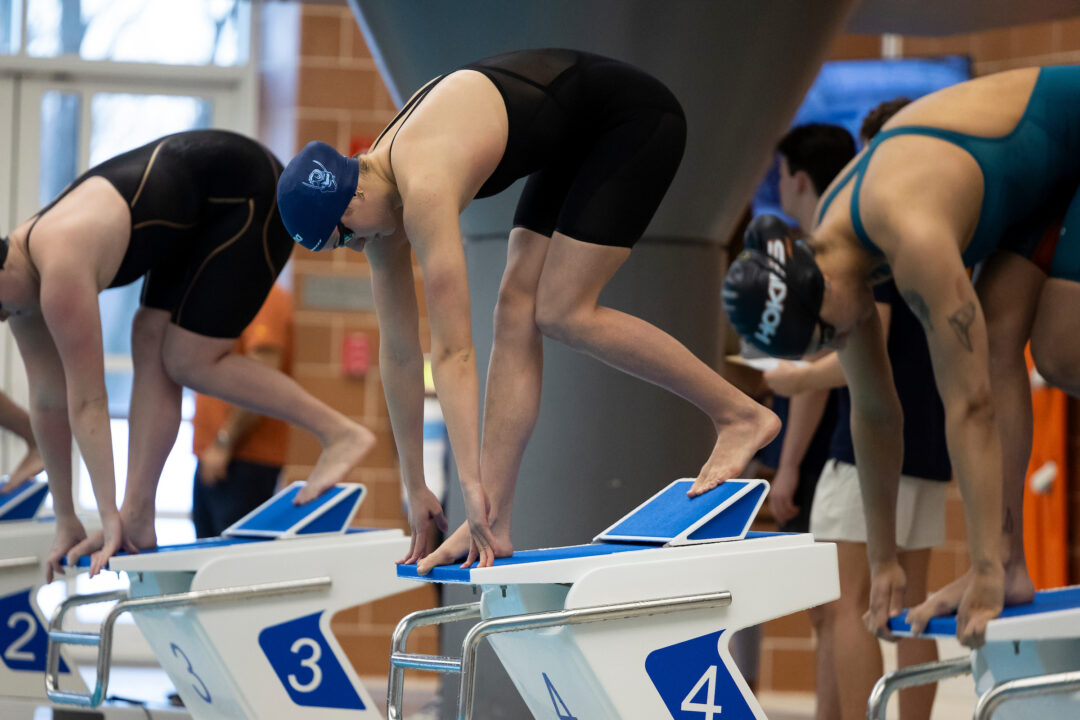Heading into this year’s NCAA Championships, the University of Virginia swim team obtained some special equipment designed to help the swimmers improve their speed off of the blocks, courtesy of Ken Ono and a group of their UVA peers.
Ono, a UVA mathematics professor and a professor of electrical and computer engineering, had previously worked alongside Todd DeSorbo’s team in utilizing video and data analysis to minimize inefficiencies in swimmers’ strokes. However, this time he wanted to work above the water, focusing on the swimmers’ explosiveness off of the blocks. He theorized that altering a swimmer’s foot placement on the block could improve the output of force that swimmer administers to the block, a term he coined “explosiveness”.
To test that theory, Ono enlisted the help of students in UVA’s Department of Electrical and Computer Engineering’s capstone course, along with Electrical and Computer Engineering Professor Adam Barnes. With the assistance of Ono and Barnes, the students were tasked with designing and implementing a system that could effectively measure a swimmer’s power output on the block, while being compatible with the NCAA-approved blocks at the UVA training facility.
The team of five students, Andy Chen, Preston Borden, Sammy Knorr, Meghana Guttikonda, and Liam Colbert, worked quickly, utilizing their one-semester course to develop the system.
Chen noted the difficulties and excitement associated with the challenge, “There’s already a super expensive commercial version out there, but we were building ours from scratch, just for the team. That’s what made it so exciting — we had to figure out how to make it work without a blueprint.”
“The mechanical portion of our system involved designing the physical surfaces that swimmers would interact with to get force data to our sensors,” Chen explained. “Because the sensors would not be used in competition, the priority was to seamlessly integrate these sensing surfaces into the start block so that swimmers feel little to no difference from the standard NCAA block.”
In the end, the team developed a sensor-embedded sleeve for the block’s flat, front-facing surface, adding sensors to the wedge covered in a clear acrylic for easy removal. Paired with an electronic unit capable of capturing and relaying the data collected from the sensors to an application developed by the team, the system proved to be a success.
Throughout the process, the team worked closely with DeSorbo and his athletes, listening to their feedback about the process, “We had weekly or sometimes biweekly meetings with the capstone group,” DeSorbo said. “And every week, I was seriously impressed with what they were doing. They’re professionals.”
The system was put to the test by some of UVA’s top swimmers, including Olympian Emma Weber. Analysis from the system proved to be successful as it showed that Weber could improve her power output off of the blocks by moving the wedge back about 3 inches. Knorr cited the result that followed, “by taking her [Weber’s] height into consideration and moving it back to position four, she was able to achieve 30 pounds more force by moving it into that position.”
For Chen, Borden, and Guttikonda, the success of the project proved even more meaningful, as the three all share a background in competitive swimming. “I’ve been a swimmer my entire life,” Guttikonda said. “I thought it would be really cool to work on a project where I got to continue that passion and make an impact at UVA.”
DeSorbo also reitterated his satisfaction with the system, saying that he forsees the next group of students working to improve it even further. “Having academics helping out athletics was probably one of the most impressive things,” DeSorbo said.

I didn’t go through all the effort of actually building out the sensors and whatnot, but pre-pandemic I led an engineering study on ways that you could gather force data on swimmers from start to finish, and we mocked up designs for block sensors.
Glad to see someone actually built something like that! Even if it never gets to the point of being integrated into NCAA/WA approved blocks, I think all of this stuff is utterly fascinating.
The commercial blocks mentioned, are those the once used at some facilities in Australia, Japan and probably a few other places?
If this works and is a lot less expensive, could this be something that could be produced and sold (could probably help a lot of people)?
In my opinion this type of research is something that is really needed. Both as to the best position of starting blocks to get the maximum take off push and also the speed of the swimmer through the air before he enters the water which might also be measured with a high speed camera. After all we now measure bullets in flight when they hit a target at a test range we should be able to measure the speed of a swimmer in the air when they leave the starting block with similar equipment.
Were the blocks only given to the women’s team?
Might want to run a spellcheck on that title.
My College friends used to say I put the Eff in efficiency. Boo yah.
Randy
awesome stuff, too bad the person that needed it the most is graduating.
Ken is not graduating. He is a professor.
Randy
D1.5 Hendricks Oort Cloud College of Astromarine Sciences Professor Davido Larvae has retired he might be filing his vacancy there
Part of shadow realm conference
is there a Paper or something about that block?
Ken Ono more like Ken oh yeah that’s a good starting block. Wow is an under overstatement. Oh yeah!
Randy